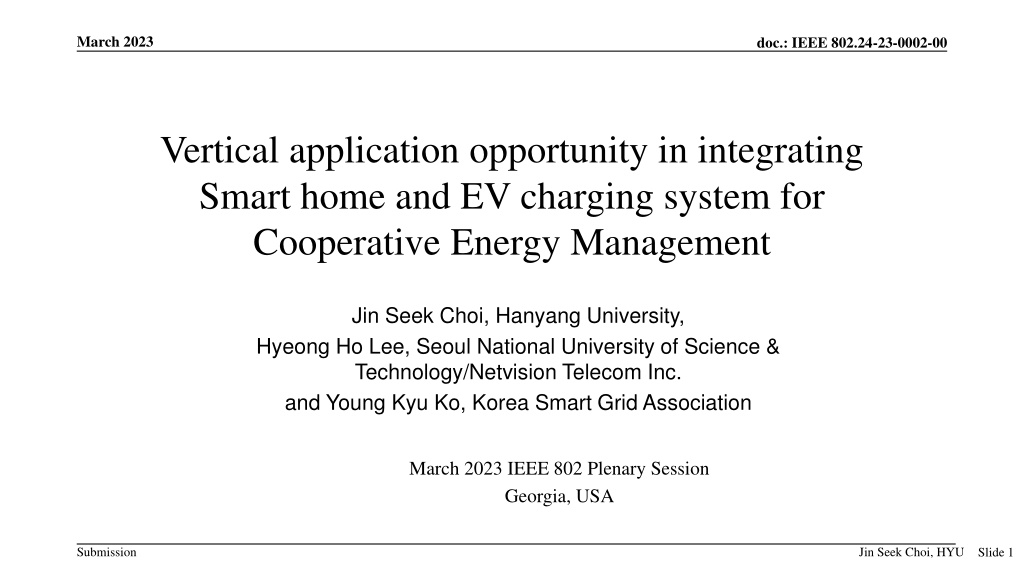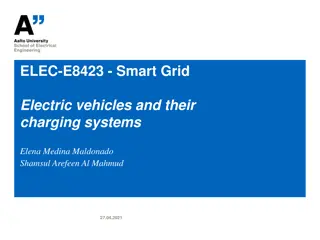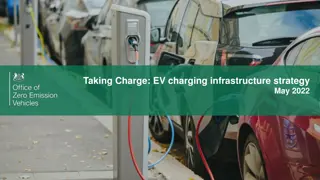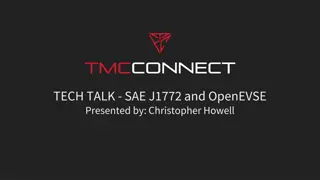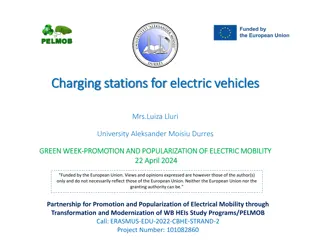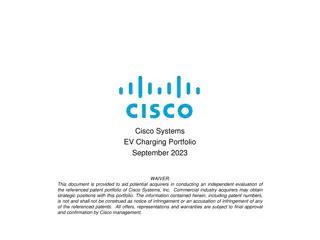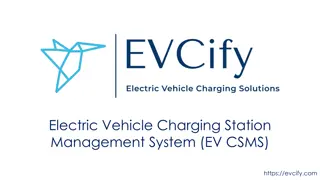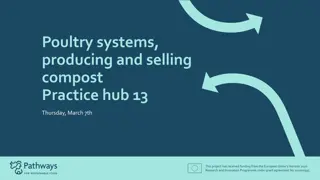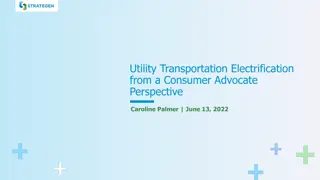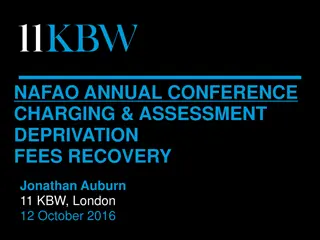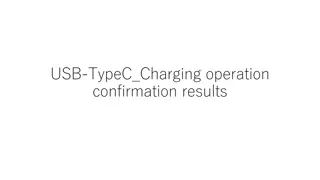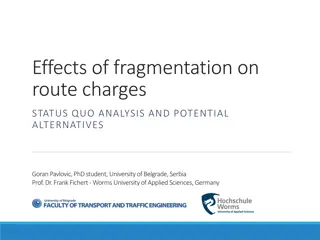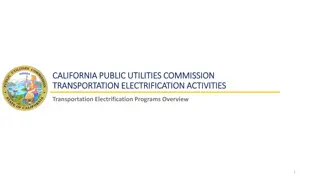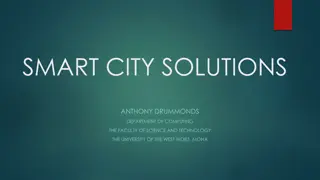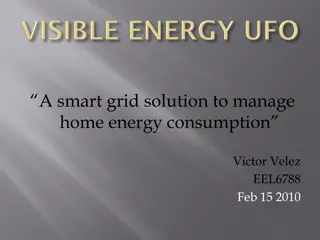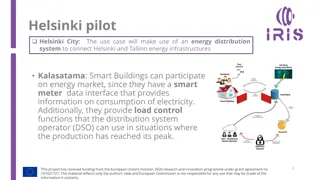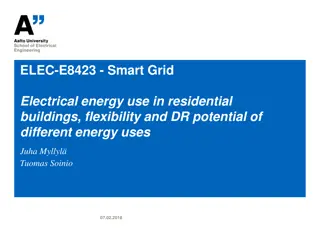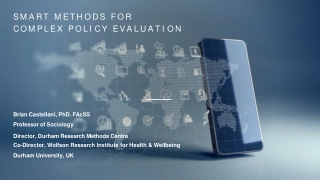Integrating Smart Home and EV Charging for Cooperative Energy Management
Explore the opportunity for integrating smart home technology and electric vehicle (EV) charging systems to enhance cooperative energy management. The IEEE 802 standard plays a significant role in enabling vertical applications tailored to specific market segments. Various network solutions and protocols like Matter and EMAP are utilized for efficient energy management in smart home environments. This initiative aims to develop a vertical application that optimizes energy distribution and usage through smart integration methods.
Uploaded on Oct 03, 2024 | 0 Views
Download Presentation

Please find below an Image/Link to download the presentation.
The content on the website is provided AS IS for your information and personal use only. It may not be sold, licensed, or shared on other websites without obtaining consent from the author. Download presentation by click this link. If you encounter any issues during the download, it is possible that the publisher has removed the file from their server.
E N D
Presentation Transcript
March 2023 doc.: IEEE 802.24-23-0002-00 Vertical application opportunity in integrating Smart home and EV charging system for Cooperative Energy Management Jin Seek Choi, Hanyang University, Hyeong Ho Lee, Seoul National University of Science & Technology/Netvision Telecom Inc. and Young Kyu Ko, Korea Smart Grid Association March 2023 IEEE 802 Plenary Session Georgia, USA Submission Jin Seek Choi, HYU Slide 1
March 2023 doc.: IEEE 802.24-23-0002-00 Contents BG: Opportunity for IEEE 802 vertical application Vertical Applications: 24-22-0012-032-0000-ieee-802-networks Wi-Fi use case for large-scale EV (AC) charging: 24-22-0016-01-0000 (Sept 2022) Wi-Fi/TSN use case for over-the-top transaction services: 24-22-0020-01-0000 (Nov 2022) A brief look at Smart Home with Renewable Energy Sources and EVs Propose: Development of an IEEE 802 vertical application integrating smart home and EV charging system for cooperative energy management Discussion and next steps Submission Jin Seek Choi, HYU Slide 2
March 2023 doc.: IEEE 802.24-23-0002-00 BG: Vertical application Vertical Applications refer to networks that serve specific use cases in specific market segments. Requirements: The network is used by the entities to enable its business processes, that usually integrate various systems including network connectivity in order to perform specific tasks or enable use cases for their industry. IEEE 802 based networks are usually aimed to enable creating/delivering a product instead of the network is the product defined by a open standard: IEEE 802 networks for e.g. time-sensitive networking (TSN), Wireless LAN, Media Independent Handover (MIH), Bridging and Management could enhance site operations and systems integration for vertical applications. IEEE 802 Network is the Access Network that connects terminally either directly through bridging or forwards traffic to the access router when the communication peer is behind the same Layer 2 domain. Various control entities support the access network to provide secured and managed connectivity. Figure 1: Network reference model design Ref: 24-22-0012-03-0000-ieee-802-networks-for-vertical-applications.docx Submission Jin Seek Choi, HYU Slide 3
March 2023 doc.: IEEE 802.24-23-0002-00 BG: Higher layer functions and service design in vertical application networks for Smart home IEEE 802 provides a high number of wired and wireless solutions for the Physical and Link layer functions of communication links to serve a very wide range of requirements of applications. Often the Generic IP protocol stack is used for realizing vertical applications, like HTTP, CoAP, or MQTT in the Application layer. IEEE 802 technologies allow for more specific network solutions when particular requirements or conditions arise. Smart Energy Profile 2 (SEP 2) is a standard for information and control for energy management. Matter is a smart-home connectivity standard. EMAP is an IEC-ISO application layer protocol among energy management agents (EMAs) for cooperative energy management in smart home environment. EMAP Applications CoAP UDP IPv4/IPv6 Figure 5: Examples of vertical applications based on IEEE 802 networking Ref: 24-22-0012-03-0000-ieee-802-networks-for-vertical-applications.docx Submission Jin Seek Choi, HYU Slide 4
March 2023 doc.: IEEE 802.24-23-0002-00 BG: Opportunity for IEEE 802 vertical application Explore how 802 services for e.g. TSN, Wireless LAN, and MIH could enhance site operations and systems integration of renewable energy sources for smart home Explore a Secure L2 EV charging communications fabric for EV applications Develop LAN architecture/s supporting site-level (depot, public fueling) operations Towards a secure, cohesive, extensible EV charging Draw on existing and coming 802.1/.3/.11 standards Example next-generation (esp. fleet) EV charging uses cases Use 802.1 TSN/Wi-Fi for transactions, high-power EV charging control Use VLANs to provide security and QOS for high-data-volume EV/AV applications, e.g. GIS data, route and schedule optimization, media services, trusted electric vehicles Ref: 24-22-0016-01-0000 (Sept 2022) Wi-Fi use case for large-scale EV (AC) charging Submission Jin Seek Choi, HYU Slide 5
March 2023 doc.: IEEE 802.24-23-0002-00 Let s take a brief look at Smart home with DERs and EVs! Smart Home can implement a system that attempts to coordinate and control when the house needs services such as heating, air conditioning, distributed energy resources (DERs) and Electric vehicles (EVs) to increase efficiency. Energy management is an early target for similar verticals such as healthcare, agriculture, manufacturing, automotive, public transportation, utilities and energy, environmental, smart cities, and more. Home Security Door lock Energy Management Home Healthcare Etc. Management Entertainment Home DERs EMA management Thermostat Dishwasher Smart meter Refrigerator HES gateway Stationary battery Air conditioner or Heat pump EVSE EVs Smart home or small building Ref: ISO/IEC 15067-3-3 Model of a system of interacting Energy Management Agents (EMAs) for demand response energy management (2019) Submission Jin Seek Choi, HYU Slide 6
March 2023 doc.: IEEE 802.24-23-0002-00 Energy management for Smart home? An Energy management Agent (EMA) is a self contained autonomous software agent for energy management by allocating/scheduling limited energy resources (e.g., thermostat) within homes and buildings. The ISO/IEC 15067-3-3 standard creates interacting EMAs for energy systems. The ISO/IEC 15067-3-31 specifies a communication mechanism through which application layer messages may be passed across EMAs. Energy Management DERs EMA EMA Thermostat Dishwasher Smart meter Refrigerator GRID EMA EMA Stationary battery HES gateway Air conditioner or Heat pump EVSE EVs Smart home or small building Ref: ISO/IEC 15067-3-3 Model of a system of interacting Energy Management Agents (EMAs) for demand response energy management (2019) Submission Jin Seek Choi, HYU Slide 7
March 2023 Energy management for Smart home with renewable energy sources and EVs? doc.: IEEE 802.24-23-0002-00 The smart home energy management framework must extend high-level communication that allow a bidirectional energy flow to support substation automation of renewable energy sources such as DERs and EVs. In this context, real-time control of the energy systems will allow the management of energy flow generated from DERs and EVs for consumption or for storage in the collective EVs. However, the control system must generate messages in a matter of milliseconds to request direct consumption at the moment of generation or for use of the reserved energy to switch the energy systems from charging mode to power supply mode. The significant advancement has been accomplished for the communication infrastructure with the special technologies that include the IEEE 1588 v2 or Precision Time Protocol (PTP) and Time-Sensitive Networking (TSN) standards to this area. These technologies are a clear evolution of the real-time control and allow synchronization levels of over 1 ms to be achieved. Submission Jin Seek Choi, HYU Slide 8
March 2023 doc.: IEEE 802.24-23-0002-00 Why we need PTP or TSN network standards? The smart home energy management framework will need to support precise control for the bidirectional energy flow to support substation automation, and it is vital to guarantee a high level of synchronization for the capture, transmission, and storage of all electrical parameters. The incorporation of PTP or TSN guarantees the high-performance synchronism of the data captured at various points in the network. This methodology will make it possible to create a virtual synchronization and approach the synchronization problem of phase, frequency, and voltage measurements. The PTP or TSN standard, allows the transmission of critical data in real time with a conventional Ethernet infrastructure in integrating smart home, DERs and EV charging system for Cooperative Energy Management. This is to ensure that real-time control can be extended to vertical applications. Thus, the smart home energy management frameworkworks with PTP or TSN standard, so that message latency is guaranteed the high-performance synchronism in integrating smart home, DERs and EV charging system for cooperative energy management. Smart Home DERs EVs Ref1: Energy Management Agent Frameworks: Scalable Flexible and Efficient Architectures for 5G Vertical Industries", IEEE Industrial Electronics Magazine vol. 15, no. 1, pp. 62-73, 2021. Submission Jin Seek Choi, HYU Slide 9
March 2023 doc.: IEEE 802.24-23-0002-00 Propose: Development of an IEEE 802 vertical application integrating smart home, DERs and EV charging system for cooperative energy management The smart home energy management framework will allow the management of energy flow generated from DERs or EVs for consumption or for storage in the collective EVs or energy storage systems [Ref1]. IEEE 802 standards allow the transmission of critical data in real time with a conventional Ethernet infrastructure in integrating smart home, DERs and EV charging system for cooperative energy management [Ref2]. To respond to voltage and frequency events in the home/microgrid/power grid in a timely fashion To Increase energy efficiency and DER resiliency via management of the EV charging infrastructure Through smart charging, the charging stations may monitor, manage (the timing to charge based on the price and needs, charging and discharging decision), and restrict the use of charging devices to optimize energy consumption. Evolution of Electric Vehicle Smart home Integration: need Collaboration and Coordination [Ref2] To take advantage of the charging system and allow for a scalable approach while improving reliability and resilience in smart home with renewable energy sources. To take advantage of Collaboration and Coordination Collaborative Autonomy to compute charging schedules and to implement demand response and ancillary services Ref1: https://www.energy.gov/eere/vehicles/electric-vehicles-scale-consortium-smart-charge-management-and-vehicle-grid Ref2: A Hierarchical Distributed Energy Management Agent Framework for Smart Homes, Grids, and Cities," IEEE Communications Magazine, vol. 57, no. 7, 2019 Submission Jin Seek Choi, HYU Slide 10
March 2023 doc.: IEEE 802.24-23-0002-00 Use case: Concrete, near-term example (new) IEEE 802 could provide a superior (secure LAN) foundation! Electric Vehicle Smart home Integration for cooperative energy management Demand Response (Save Excessive Energy by using EVs) Demand Response (Vehicle-to-home) 802.11/TSN for integrating Smart Home, DERs and EV (AFV) charging [Ref1] EV joins smart home Wi-Fi network, negotiates fueling service parameters On-site edge/cloud services platform directs EV(AFV) to fueling bay (EVSE) Coupling to fueling device could be robotic, controlled via Wi-Fi Charging control (conductive or inductive) could be Wi-Fi as well 802.11/TSN for Energy, Assets and security management negotiates fueling service parameters with EV Secure LAN/HES gateway for protect privacy and security Dishwasher Refrigerator DERs Thermostat EMA EMA Smart meter EMA GRID EMA Stationary battery Air conditioner or Heat pump HES gateway Home/Building EVSE EVs Ref1: Energy Management Agent Frameworks: Scalable Flexible and Efficient Architectures for 5G Vertical Industries", IEEE Industrial Electronics Magazine vol. 15, no. 1, pp. 62-73, 2021. Submission Jin Seek Choi, HYU Slide 11
March 2023 Requirement: discussion with IEEE Std P802.11/TSN ? doc.: IEEE 802.24-23-0002-00 How could 802.11/TSN standards support secure and reliable communications for energy management integrating EV charging system and DERs? Critical functions must be operational and resilient Data privacy for fueling, power/energy distribution, logistics, operations Coordinated security contexts Fueling: vehicle, dispenser, energy sources and sinks; safety-critical? Load balancing: Demand Response Data: public/private, site/region, cooperating entities; trust domains Architecture Distributed energy, computing, control Orchestration of workloads between edge/cloud Vehicle-to-Home & Home-to-Vehicle UML Data Modeling Energy (DR) Management Control CoAP/ HTTP UDP/IPv6 802.11/TSN (synchronization) Submission Jin Seek Choi, HYU Slide 12
March 2023 doc.: IEEE 802.24-23-0002-00 Discussion, next steps Thank you very much! jinseek@hanayng.ac.kr Submission Jin Seek Choi, HYU Slide 13
